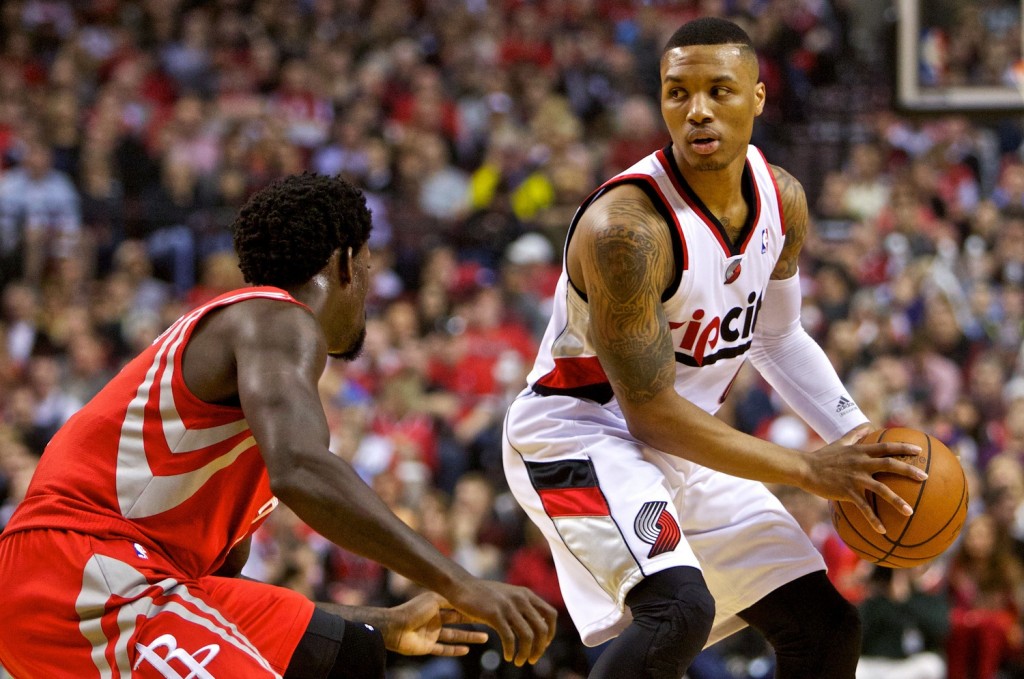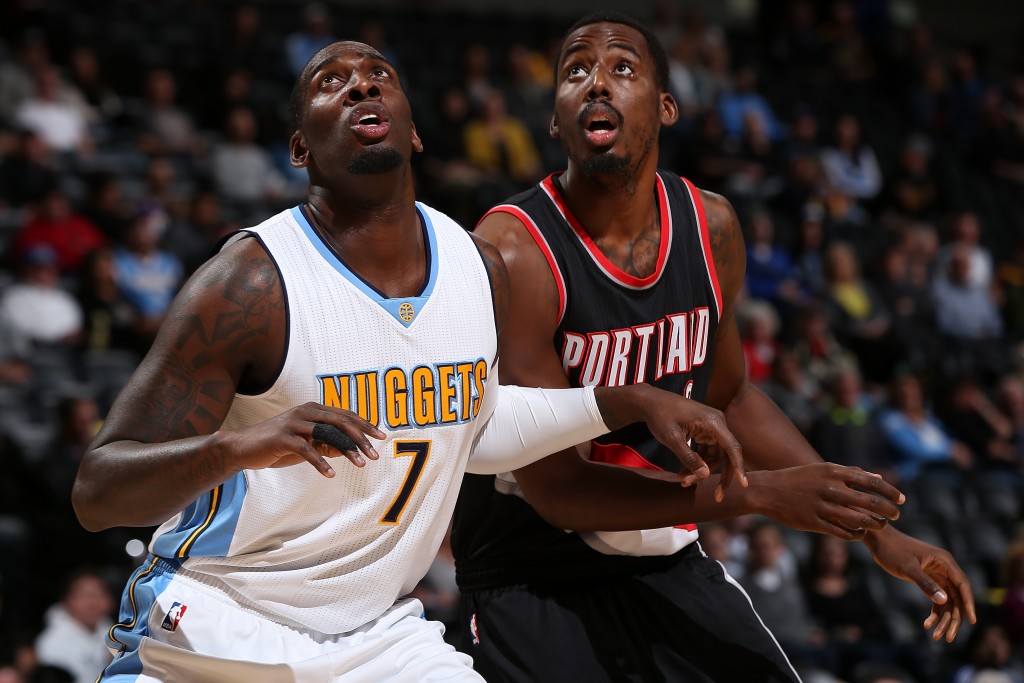The first Blazers possession of the season was pure magic: Damian Lillard tosses the ball to Meyers Leonard, who seals his man and pitches to CJ McCollum. Moving right to left above the break, McCollum hands off to Al-Farouq Aminu, who uses a Mason Plumlee back screen above the nail to drive toward the basket. When Aminu’s man ices him, Aminu wraps underneath the basket, flinging the ball to McCollum in the corner. This leads to a Plumlee/McCollum pick-and-roll, and when Plumlee draws Aminu’s man on the roll, he flings an awkward but accurate no-look pass to Aminu in the short corner. Swish.
Six passes, three points, one shot. Portland outscored New Orleans, a preseason pick to contend in the Western Conference, 43-18 in the first quarter en route to a blowout victory.
This play encapsulated exactly what many of us wanted the 2015-’16 Blazers to be — we had to wait all of 30 seconds for Christmas morning. GM Neil Olshey promptly reloaded his team around his incumbent star Damian Lillard, securing a young core of shooters and athletes at a bargain-bin price. Sure, Portland wouldn’t be “good,” but they’d be “fun” — loads of 3-pointers, fastbreaks and a bundle of 120-118 scores. The 2015-’16 Blazers were a League Pass fantasy come true.
We’ve learned a few things in the 11 Blazer games following opening night, which includes eight losses and only 100.4 points per game. For starters, New Orleans isn’t as good as we thought; just about every Pelicans’ opponent has scored on them like the Blazers did.
A pair of solid takedowns by @RobMahoney https://t.co/FBggMyrkU2 and @nicobaguio https://t.co/TE9gibElME. Distressing start for Pellies.
— Joe Manganiello (@thatjoemags) November 16, 2015
Portland has lost six straight games since opening the year at 4-2. Victories at Utah and against New Orleans and Memphis spurned the question, “Might the Blazers actually be good?” The Blazers also dropped a pair of games to the Suns on back-to-back nights in October while failing to break 92 points. While Portland’s schedule hasn’t been a piece of cake, including losses to the new-look Pistons, Spurs and an unsuccessful rematch in the Grindhouse, the Blazers have also dropped games to the Nuggets and Hornets.
What could have been a high-wire act offense gallivanting through the league at a Top 5 pace, the Blazers have instead been pedestrian in the early-goings. Portland hasn’t eclipsed 104 points during the losing streak, and the team is 22nd in pace at 97.67 possessions per 48 minutes.
Lillard and McCollum have been productive. McCollum is enjoying an encore of his postseason coming out party, scoring 20.4 points a night, while Lillard has raised his scoring clip to 25.3 points in the aftermath of LaMarcus Aldridge fleeing for San Antonio. Defenses must think they’re seeing double, or that Portland has access to sorcery of The Prestige, because Lillard and McCollum have a striking resemblance — on the court and stat sheet. The players are both shooting 38 percent from deep on 13.4 combined attempts, and 44 percent from the field on 37.7 shots.
Having one or both of Lillard and McCollum on the floor places constant pressure on opposing guards. These are quicksters who can capitalize on the shortest of gaps in a blink. Defenses can’t lose track of them, and sometimes even attentiveness isn’t enough if the team’s ancillary pieces are making plays around them.
Starting Lillard and McCollum comes with its disadvantages defensively, but the Blazers, who owe a 2016 lottery-protected pick to Denver for the Arron Afflalo trade, aren’t competing for a championship just yet. In the 298 minutes the backcourt has played, the Blazers are allowing 105.5 points per 100 possessions, per NBA.com. The starting lineup with Meyers Leonard, who had shoulder surgery last week and might miss 4-6 weeks, has surrendered an agonizing 109.8 points per 100. Again, that much was foreseeable, and those defensive figures will inch toward respectability as this nucleus gains its footing.
The unexpected trauma from last season’s roster turnover has been finding consistent buckets. Portland has an offensive rating of 102.9, down from 105.5 a season ago, and coupled with a doe-eyed defense, the team is being outscored by 2.4 points per 100 possessions.
Terry Stotts has the Blazers playing at a curtailed pace, presumably in order to minimize the number of possessions the group has to defend. It’s a fine idea, and it reinforces the basic necessity of building a winning defense — it’s his second go-around with building a workable unit out of mostly offensive personnel. There are sizable differences between this group and its predecessor, however. The Aldridge/Wes Matthews/Nic Batum outfit seldom forced turnovers or scored in transition, but the team could overcome those disadvantages by getting easy points from a myriad of sets.
Portland’s offensive production has been uneven through a dozen games. On the one hand, the starting lineup is scoring more than 111 points per 100 possessions, per NBA.com, but those numbers are skewed from the blowout wins against New Orleans and Memphis (see: sample size). Most of the Blazers’ games this season have been grind-it-out affairs more favorable to experienced teams.
The Grizzlies were up double-digits well into the second half on Friday, picking apart the Blazers with high-low, Marc Gasol/Zach Randolph actions. The game changed when Portland began knocking down open jumpers, but it still took a couple bonehead Tony Allen plays for Memphis to give the majority of its lead away. And Memphis still took the game when Stotts decided to stay small in the closing seconds, leading to a pair of Randolph offensive rebounds and the game-winning layup:
Tune into Portland on League Pass right now, and you’ll see fewer Lillard/McCollum semi-transition assaults then you’d hope for. The Blazers from opening night have been hard to find:
Portland is in the bottom 5 of the NBA in assist-percentage (52.9), and is just 23rd in fastbreak points. The offense lives and dies with the 3-ball, but the Blazers are 3rd in the NBA in unassisted 3PM, which make up 26.8 percent of their points. Portland is 5th in unassisted FGM (47.1), but only 24th in points in the paint (39 ppg). The bulk of their baskets are coming from isolation, not post-ups or in transition, which can lead to higher efficiency shots.
The Blazers are 4th in the league in percentage of points from behind the arc at 27.9 percent. This team can shoot, to be sure — Portland is 5th in eFG% (51.1) and 7th in true-shooting (54.3). The isolation-heavy offense would benefit from an uptick in foul-shooting, but the Blazers are only scoring 26.6 percent of their points at the line, 18th in the NBA.
Meanwhile, Blazer opponents are getting a bevy of easy shots against this young team: teams are shooting a whopping 50 percent on 2s, and scoring 43.5 points in the paint against them. No team in the NBA forces less turnovers per game, and on the flip-side Portland is 21st in turnover ratio (15.6), meaning the Blazers are giving a significant number of possessions away while not earning them back. Portland is dead last in the NBA in points off opponents’ turnovers, gifting the other team roughly six points per game.
The one true spark for Portland among its new additions has been Aminu. “The Chief” is good for at least one one-man fastbreak each night. He’s a soul-crushing shot-blocker when his man makes the mistake of dragging him near the paint.
Aminu’s destiny could be as a stretch-4 where his improved shooting stroke would pop out and his rebounding/defensive presence would yield more of an impact. For now, the Blazers need Aminu as protection for McCollum and Lillard on the perimeter, and in the meantime he’s demonstrated a knack for timing the weak-side rejection.
https://www.youtube.com/watch?v=NfAhIPePvDM
Aminu doesn’t have a traditional wing’s game. He’s not a creator and doesn’t naturally look to attack or get his own shot. When he’s given space, though, Aminu can cut into the lane and cause problems as a rim rocker. He’s knocking down 1.6 3PM per game on 37 percent shooting, and defenses are beginning to take notice. On this connection from Plumlee, Aminu shows heady instinct in the pick-and-roll, drawing his defender away from the basket before cutting:
Aminu has been the key to the Blazers’ two-way success. When he’s on the floor, Portland is outscoring opponents by 4.5 points per 100 possessions behind a Top 5 offense and mediocre defense. In the 185 minutes he’s been off the floor, typically replaced by Allen Crabbe, Maurice Harkless or Gerald Henderson, the Blazers… oh boy… it gets ugly (93.6 OffRtg, 110.4 DefRtg and -16.8 NetRtg).
Those numbers make Aminu look like Kawhi Leonard, which he isn’t, but the difference between playing a lineup with five defensive minuses or four is significant. It’s hard to be a great scoring team if your opponent is getting easier looks than you on additional chances, and the Blazers’ defensive inefficiencies harbor this very problem. The solution in the short-term should be to play faster and secure more easy points — i.e. transition chances, points off turnovers, foul shots, etc. This will also make the Blazers the joyous League Pass experience we all wanted. Let Lillard, McCollum and Aminu loose, and the floor will open up.



